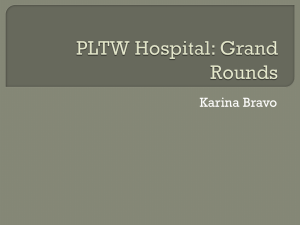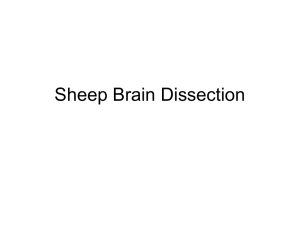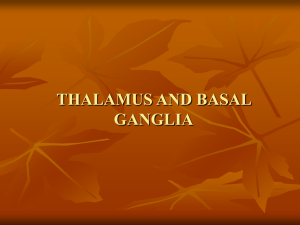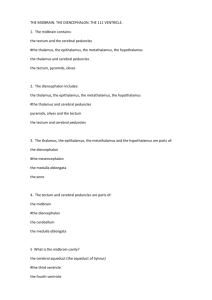Brain
advertisement
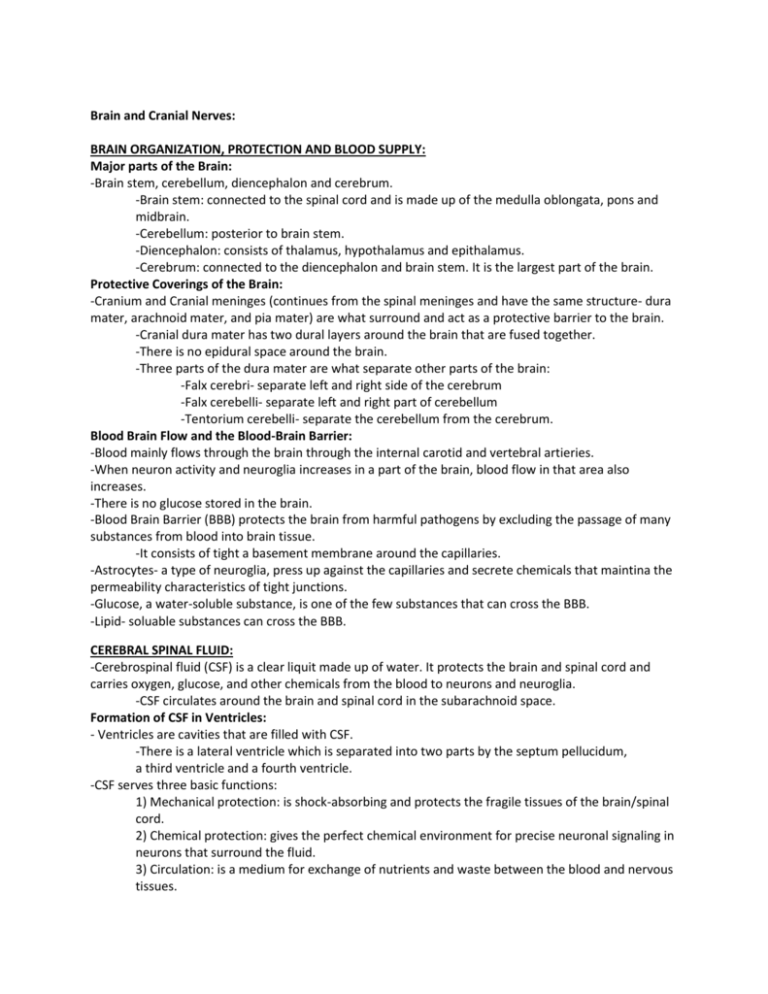
Brain and Cranial Nerves: BRAIN ORGANIZATION, PROTECTION AND BLOOD SUPPLY: Major parts of the Brain: -Brain stem, cerebellum, diencephalon and cerebrum. -Brain stem: connected to the spinal cord and is made up of the medulla oblongata, pons and midbrain. -Cerebellum: posterior to brain stem. -Diencephalon: consists of thalamus, hypothalamus and epithalamus. -Cerebrum: connected to the diencephalon and brain stem. It is the largest part of the brain. Protective Coverings of the Brain: -Cranium and Cranial meninges (continues from the spinal meninges and have the same structure- dura mater, arachnoid mater, and pia mater) are what surround and act as a protective barrier to the brain. -Cranial dura mater has two dural layers around the brain that are fused together. -There is no epidural space around the brain. -Three parts of the dura mater are what separate other parts of the brain: -Falx cerebri- separate left and right side of the cerebrum -Falx cerebelli- separate left and right part of cerebellum -Tentorium cerebelli- separate the cerebellum from the cerebrum. Blood Brain Flow and the Blood-Brain Barrier: -Blood mainly flows through the brain through the internal carotid and vertebral artieries. -When neuron activity and neuroglia increases in a part of the brain, blood flow in that area also increases. -There is no glucose stored in the brain. -Blood Brain Barrier (BBB) protects the brain from harmful pathogens by excluding the passage of many substances from blood into brain tissue. -It consists of tight a basement membrane around the capillaries. -Astrocytes- a type of neuroglia, press up against the capillaries and secrete chemicals that maintina the permeability characteristics of tight junctions. -Glucose, a water-soluble substance, is one of the few substances that can cross the BBB. -Lipid- soluable substances can cross the BBB. CEREBRAL SPINAL FLUID: -Cerebrospinal fluid (CSF) is a clear liquit made up of water. It protects the brain and spinal cord and carries oxygen, glucose, and other chemicals from the blood to neurons and neuroglia. -CSF circulates around the brain and spinal cord in the subarachnoid space. Formation of CSF in Ventricles: - Ventricles are cavities that are filled with CSF. -There is a lateral ventricle which is separated into two parts by the septum pellucidum, a third ventricle and a fourth ventricle. -CSF serves three basic functions: 1) Mechanical protection: is shock-absorbing and protects the fragile tissues of the brain/spinal cord. 2) Chemical protection: gives the perfect chemical environment for precise neuronal signaling in neurons that surround the fluid. 3) Circulation: is a medium for exchange of nutrients and waste between the blood and nervous tissues. -Choroid Plexuses- blood capillaries in the walls of ventricles that produce CSF. - Blood-cerebospinal fluid barrier: allows certain substances to enter the CSF and is made by tight junctions of ependymal cells. Circulation of CSF: -CSF is formed in the choroid plexuses of the lateral ventricle, flows into the third ventricle and flows through the aqueduct of midbrain which passes through the midbrain into the fourth ventricle. -CSF enters the subarachoid space through three openings found in the roof of the fourth ventricle: 1) median aperture 2)and two lateral apertures -CSF is absorbed into the blood through arachnoid villi- extensions of the arachoid that connect to the dural venous sinuses which are non-collapsible spaces. THE BRAIN STEM: Medulla Oblongata: -Connects to the spinal cord and forms the interior part of the brain stem beginning at the magnum foramen and ends at the inferior border of the pons. -the medulla is largely covered by the cerebellum - gives rise to many cranial nerve roots. - includes white matter that has sensory and motor tracts extending between the spinal cord and some parts of the brain. -Pyramids are the bulges of white matter on the anterior part of the medulla. - Decussation of the pyramids are crossings of axons between the left and right pyramids. -This explains why each side of the brain controls movements on the opposite side of the body. -Medulla contains several nuclei. -Cardiovascular center controls the rate and force of heartbeat and the diameter of blood vessels. -Medullar rhythmic area adjusts the rhythm of breathing. -Lateral the each pyramid is an olive- and oval shaped bump and within each olive is the interior olivary nucleus. -Sensations of touch, conscious proprioception, pressure and vibration are located in the posterior part of the medulla called the right and left gracile nucleus and cuneate nucleus. -Medulla is associated with VII, IX, X, XI and XII. Pons: -the posterior part of the pons makes the floor of part of the fourth ventricle. -superior to the medulla and anterior to the cerebellum. -consists of both nuclei and tracts. -Pons have two major structural components: 1) ventral region – makes a synaptic relay station consisting of scattered gray centers called pontine nuclei. 2) dorsal region -Pons is associated with V, VI, VII, VII cranial nerves. Midbrain: -superior to pons. -starts at pons and ends at the diencephalon. -cerebral aquaduct passes through the midbrain and connects the third ventricle with the fourth. -has both nuclei and tracts. -Cerebral penducles are a pair of tracts that are the anterior part of the midbrain. -contain axons of corticospinal, corticopontine and corticobulbar motor neurons that conduct nerve impulses from the cerebrum to the spinal cord, medulla and pons and sensory neurons that go from the medulla to the thalamus. -Tectum is the posterior part of the midbrain and contains four rounded bumps called the superior colliculi and inferior colliculi. -Midbrain consists of several nuclei: left and right substantia nigra and left and right red nuclei. - Midbrain is associated with III and IV cranial nerves. Reticular Formation: -Reticular formation: large region where white matter and gray matter exhibit a netlike formation. -starts from the superior part of the spinal cord, throughout the brain stem, and into the interior part of the diencephalon. - Reticular activating system (RAS) is a part of the reticular formation that consists of sensory axons that go into the cerebral cortex. THE CEREBELLUM: -The cerebellum lies on the dorsal part of the brain stem. -it is attached by the three cerebellar peduncles on each side. -Big part in coordinating muscular activity and learning motor tasks. -Cerebellum is the second largest part of the brain. -transverse fissure is what separates the cerebellum from the cerebrum. -Tentorium cerebelli is a tentlike fold of the dura mater that is connected to the temporal and occipital bones. -Vermis- area that is constricted between the two hemispheres of the cerebellum. THE DIENCEPHALON: -diencephalon forms a central core of brain tissue superior to the midbrain. -contains multiple nuclei. -starts from the brain stem to the cerebrum and surrounds the third ventricle which includes the thalamus, hypothalamus and epithalamus. Thalamus: -a bridge of gray matter called the intermediate mass connects the right and left halves of the thalamus. -major stations for most sensory impulses that reach the primary sensory areas of the cerebral cortex from the spinal cord, brain stem and midbrain. -Internal capsule- a thick band of white matter lateral to the thalamus. -Internal medullary lamina- divides the gray matter of the right and left parts of the thalamus. -There are seven major groups of nuclei on each side of the thalamus: 1) Anterior nucleus 2) Medial nuclei 3) Lateral group 4) Ventral group 5) Intralaminar nuclei 6) Midline nucleus 7) Reticular Nucelus Hypothalamus: -small part of the diencephalon inferior to the thalamus. -has a dozen or so nuclei in four major regions: 1) mammillary region 2) Tuberal region 3) Supraoptic region 4) Preoptic region -the hypothalamus has control over: -the ANS -Production of hormones -Regulation of emotional and behavioral patterns -Regulation of eating and drinking -Body temperature -Circadian rhythms and states of consciousness. Epithalamus: -small region superior and posterior to the thalamus and consists of the pineal gland and habenular nuclei. Circumventricular Organs: -parts of the diencephalon are called CVOs because they are in the wall of the third ventricle and can monitor chemical changed in the blood due to the fact that they lack a BBB. THE CEREBRUM: - largest portion of the human brain that has the cerebral hemispheres and the basal ganglia. -gyri are the folds on the brain -sulci are the grooves -fissures are the deepest grooves on the brain. corpus callosum is what connects the hemispheres. Lobes of the Cerebrum: - frontal, parietal, temporal, insula and occipital. Cerebral White Matter: - consists of myelinated axons in three types of tracts: 1) association tracts 2) commissural tracts 3 projection tracts Basal Ganglia: - three nuclei in the cerebra hemisphere known as the globus pallidus, putamen and caudate nucleus. -Lentiform nucleus is the name of both the globus pallidus and putamen. -Corpus striatum is the name of the lentiform nucleus and the caudate nucleus. The Limbic System: -encircling the upper portion of the brain stem and the corpus callosum is a ring of structures that makes up the limbic system. -The main components are: 1) Limbic lobe 2) Dentate Gyrus 3) Amygdala 4) septal nuclei 5) mammillary bodies of the hypothalamus 6) anterior nucleus and medial nucleus 7) olfactory bulbs 8) fornix, stria terminalis, stria medullaris, medial forebrain bundle and mammillothalamic tract. FUNCTIONAL ORGANIZATION OF THE CEREBRAL CORTEX: Sensory Areas: -mainly in the posterior half of both cerebral hemispheres. -primary somatosensory areas: located posterior to the central sulcus of each cerebral hempisphere in the postecenral gyrus of each parietal love. -goes from the lateral cerebral sulcus, along the lateral surface of the parietal love to the longitudinal fissure and then along the medial surface of the parietal love within the longitudinal fissure. -It is the primary visual area, auditory area, gustatory area and olfactory area. Motor Areas: - Primary motor area is in the precentral gyrus of the frontal lobe. -Broca’s speech area is located in the frontal love close to the lateral cerebral sulcus. Association Areas: -somatosensory association -prefrontal cortex -visual association area -auditory association area -Wernicke’s area -common integrative area -premotor area -frontal eye field area CRANIAL NERVES: -12 pairs that pass through various parts of the brain in the brones of the cranium and cranial cavity. Olfactory (I) Nerve -goes through the cribiform plate of the ethmoid bone -sensory: smell -olfactory epithelium occupies the superior part of the nasal cavity. -the olfactory receptors are bipolar neurons. Optic (II) Nerve -goes through the optic foramen -sensory: vision -Axons of the ganglion cells in the retna of the eyes come together to make an optic nerve. -the two optic nerves merge to make the optic chiasm. Oculomotor (III) Nerve -goes through the superior orbital fissure - motor: 4 of 6 eyeball muscles -how eyes move up, down and side to side -the motor nucleus is in the anterior part of the midbrain -sensory: proprioception Trochlear (IV) Nerve - goes through the superior orbital fissure -motor: superior oblique -sensory: proprioception -smallest of the 12 cranial nerves and is the only one that comes from the posterior part of the brain stem. Trigeminal (V) Nerve -made up of the three branches that cover the head- sensory from face: -opthalmic: goes through the superior orbital fissure -maxillary: goes through foramen rotundum -mandibular: goes through foramen ovale -motor: muscles of chewing Abducens (VI) Nerve -goes through the superior orbital fissure -motor: lateral rectus -sensory: proprioception -got its name because nerve impulses cause abduction of the eyeball. Facial (VII) Nerve -goes through the stylomastoid foramen -motor: muscles of the face -sensory: proprioception -the sensory axons extend from the taste buds of the anterior two-thirds of the tongue. Vestibulocochlear (VIII) Nerve -goes through the internal auditory meatus a) chochlear branch: hearing from the choclea b) vestibulochlear branch: equilibrium from the semicircular canals Glossopharyngeal (IX) Nerve -goes through the jugular foramen -sensory: taste- the posterior one third of the tongue, carotid sinus and the upper pharynx also known as the gag reflex. Vagus (X) Nerve -goes through the jugular foramen -motor: airways, lungs, heart, esophagus, stomach, small intestine, most of the large intestine and the gallbladder (viscera) Accessory (XI) Nerve -goes through the jugular foramen -motor: muscles of swallowing, sternocleidomastoid muscles and trapezius muscle. -sensory: proprioception Hypoglossal (XII) Nerve -goes through the hypoglossal canal which is next to the occipital condyles. -motor: muscles of the tongue -sensory: proprioception.


